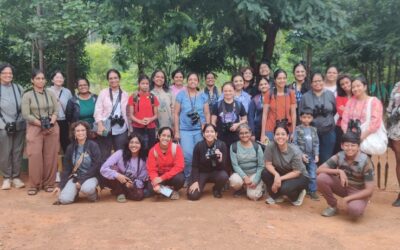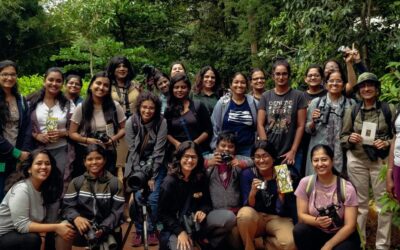The 12th AWNW was held on 4 August 2024 at Turahalli Tree Park and over 45 women participated in this walk!
At around 8.30 am, we all gathered inside the gate of the park. In addition to the women present, we also had a couple of extremely enthusiastic children with us.
We began with a quick round of introductions and an overview of what AWNW is all about. Uma Vaijnath, a birder and nature enthusiast who lives close to this site, talked about the habitat and safety precautions to keep in mind during the exploration.
The walk began with a glimpse of a Bauhinia tree. We discussed the various common names this species has: Butterfly Tree, Purple Orchid Tree. And since the bilobed leaves resemble the shape of a camel’s hoof, it’s called Camel’s Foot Tree. Deepa Mohan added that the genus was named after the Bauhin brothers, Swiss-French botanists. We huddled close to take a closer look at an Acacia leucophloea, or White-barked Acacia. While the branches didn’t have many thorns, the trunk had clusters of them sticking out. These thorns are a testament to millions of years of evolution, protecting them from hungry herbivores in arid regions. Interestingly, certain animals, such as Nilgais in India, have evolved strategies to consume these long-spined species without harm! In some parts of India the bark is used to distil local liquor, hence its other name, Distiller’s Acacia.
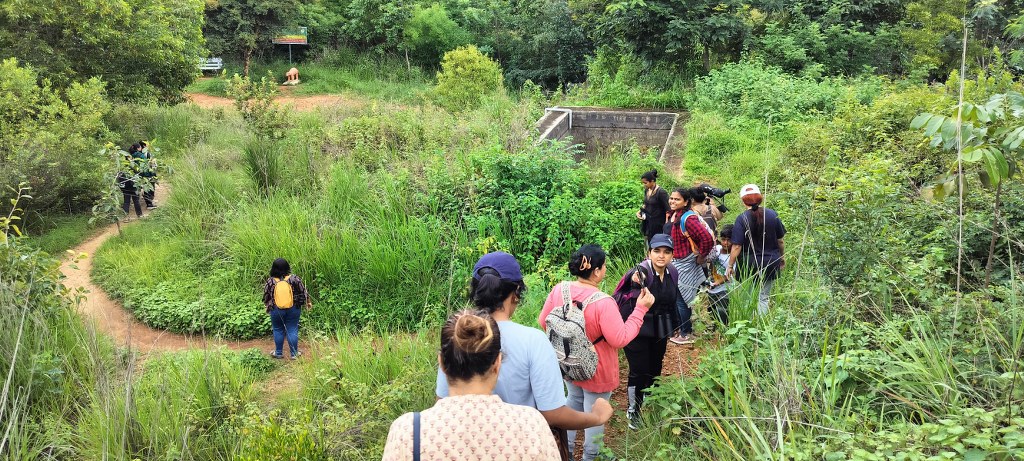
Photo Credit: Surekha
The loud songs of the Common Tailorbird and Ashy Prinia soon distracted us. All of us opened Early Bird’s bird pocket guides to find the tailorbird. The Merlin Bird ID app was useful for listening to this species’ calls and songs. When we asked the kids why the tailorbird is called a tailorbird, they looked at the photographs and explained that it’s because of its long tail :-). The Common Tailorbird gets its name from its unique nest-building technique. It quite literally “sews” leaves together to create a cosy home for its eggs! We also saw a pair of Asian Green Bee-eaters hunting insects mid-air. These colourful birds are skilled aerial hunters. They catch insects, particularly bees and wasps, in mid-flight. Before eating their prey, they remove the stinger by repeatedly hitting and rubbing the insect against a rough surface.
The butterfly enthusiasts among us were thrilled to spot the Great Eggfly. The males of this species sport large, egg-like spots on their wings. We even witnessed two Indian Jezebel butterflies emerging from their chrysalises—a truly magical moment! Flacourtia indica, or Governor’s Plum, was in full bloom, attracting a lot of insect pollinators, mainly wasps and flies. In the same vicinity, there was a lot of activity for butterflies: Common Leopard, Angled Castor, Tawny Coster, Grass Yellows (Eurema sp.).
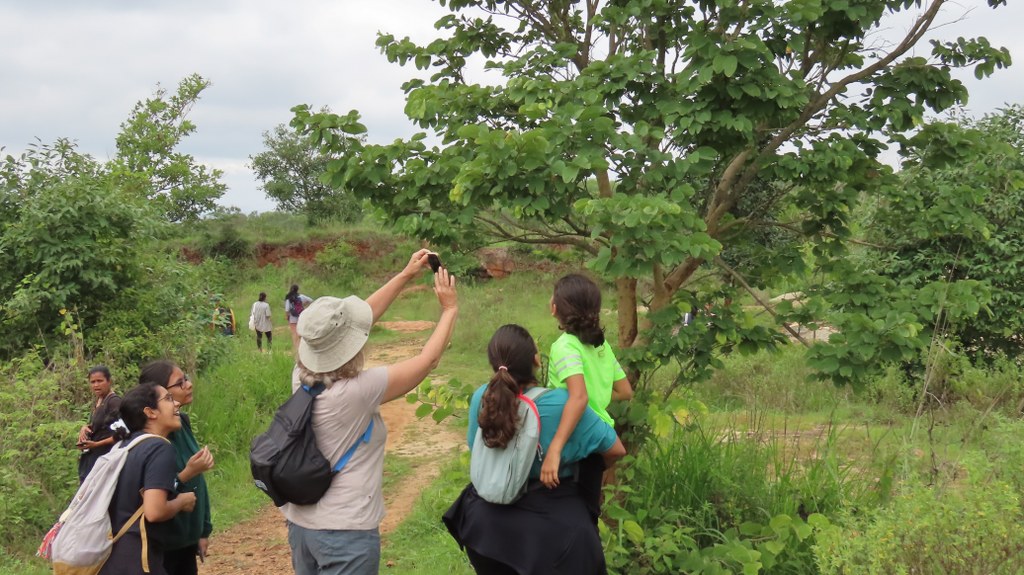
Watching bright yellow-orange Indian Jezebels that had just emerged. Photo Credit: Nisha B.
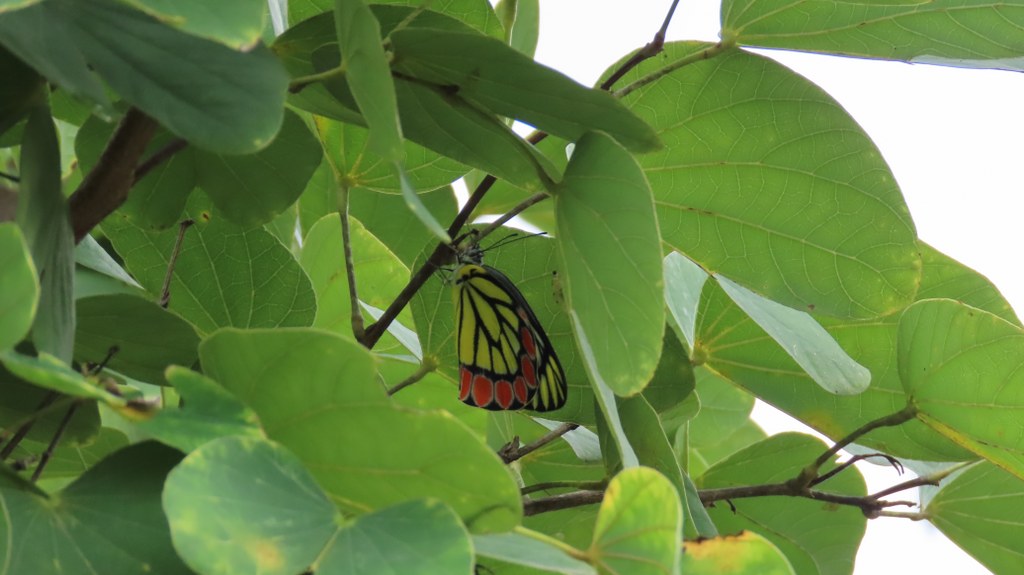
Indian Jezebel. Photo Credit: Nisha B.
One of the highlights was observing a Praying Mantis creating its ootheca (egg case). It seems like we have been lucky with spotting interesting Praying Mantis behaviour (on our last walk, we saw one feeding on a butterfly). These fascinating insects have been around for over 140 million years, outliving the dinosaurs thanks to their incredible adaptations and camouflage abilities.

A Praying Mantis that has just finished creating a Ootheca 9egg case). Photographed by Nisha B.
All along the walk, we came across many small things which could have easily been missed– tiny Spittlebugs, Blister Beetles, Ant-mimic Spider and Ant-mimic Mamtis, Jumping Sider, Crab Spider. Tussock Moth Caterpillars and many more. Every step of our walk revealed new wonders. One of us in the group spotted Bird’s nest fungi growing in the ground. These fungi are slightly bigger than your fingernail and we could have been easily missed.
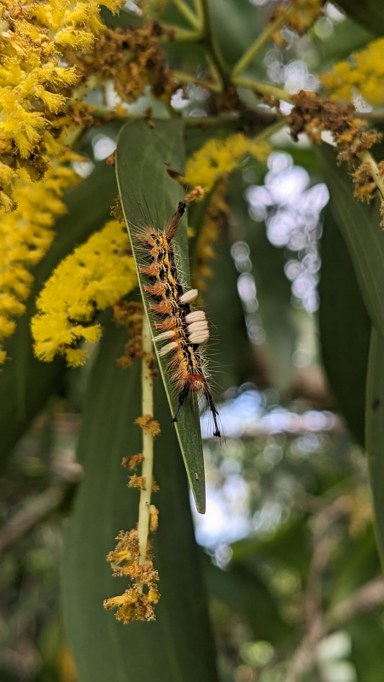
Tussock Moth Caterpillar: Photo Credit: Manini Bansal

Bird’s Nest Fungi. Photo Credit: Sandhya

Crab Spider. Photo Credit: Manini Bansal
We came across a structure designed to provide a habitat for solitary bees and we learnt that its called a bee hotel. It featured a variety of holes and tubes of different diameters to accommodate various species, as solitary bees do not live in colonies but create individual nests. These bees are excellent pollinators, enhancing the health and productivity of gardens and crops. Providing nesting sites like this helps support and conserve local bee populations, many of which are declining due to habitat loss.

A Bee Hotel located inside the Turahalli Tree Park. Photo Credit: Meenakshi
On our way back, we spotted a Shikra which stayed perched long enough to give every one a decent look. A female Koel too was perched on top a bare tree branch and offered good views.
As we concluded our walk, we all felt a deeper connection to the intricate web of life around us. It’s amazing how much diversity exists right in our backyard, waiting to be discovered and appreciated.

- Photo album (coming soon)
Trees and Plants:
- Camel’s Foot Tree
- White-barked acacia
- Jamun
- Pride of India
- Ear-leaf Acacia
- Mahogany
- Sandalwood
- Bastard Sandal
- Gulmohar
- Banyan
- Ficus sp.
- Singapore Cherry
- Pongam Tree
- Paper Mulberry
- Governor’s Plum
Birds:
Butterflies:
- Common Crow (Probably was female of Great Eggfly)
- Great Eggfly (Male)
- Indian Jezebel
- Common Leopard
- Angled Castor
- Tawny Coster
- Pioneer
- Grass Yellow
Insects and Arachnids:
- Praying mantis (just finished making Ootheca)
- Spittlebugs
- Ant mimic spider
- Asian Ant Mantis
- Domino cockroach
- Tussock moth caterpillar
- Crab spider
- Blister beetle
- Cotton stainer bug
- Carpenter bee
- Millipede
Fungi:
- Parasola sp.
- Bird’s nest fungus. Read more here in Deepa Mohan’s Blog
Note: The above list may not be a complete list of all species seen.
Resources:
Butterflies: I found Butterflies
Plants: Flowers of India
Birds: Merlin Bird ID App and Early Bird Pocket Guides
All others: iNaturalist, India Biodiversity Portal
Click here to see recap of July 2024 walk.
Feeling inspired? Join the AWNW flock for their next walk! Follow us on Instagram for updates, and connect at awnw.india@gmail.com
Banner Image by Deepa Mohan


